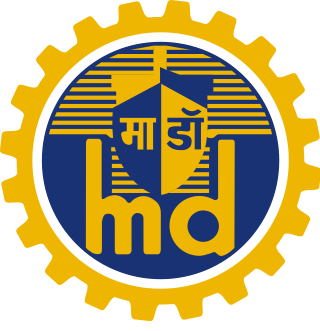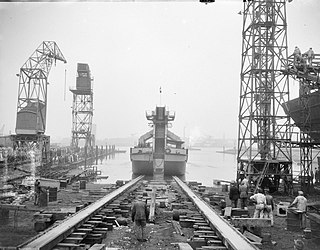
Dredging is the excavation of material from a water environment. Possible reasons for dredging include improving existing water features; reshaping land and water features to alter drainage, navigability, and commercial use; constructing dams, dikes, and other controls for streams and shorelines; and recovering valuable mineral deposits or marine life having commercial value. In all but a few situations the excavation is undertaken by a specialist floating plant, known as a dredger.

The Port of Karachi is one of South Asia's largest and busiest deep-water seaports, handling about 60% of the nation's cargo located in Karachi, Pakistan. It is located on the Karachi Harbour, between Kiamari Azra Langri, Manora, and Kakapir, and close to Karachi's main business district and several industrial areas. The geographic position of the port places it in close proximity to major shipping routes such as the Strait of Hormuz. It is also ideally located to offer gateway services to the maritime trade for the Central Asian Republics (CARs). The administration of the port is carried out by the Karachi Port Trust, which was established in 1857.

Mazagon Dock Shipbuilders Limited (MDL), formerly called Mazagon Dock Limited, is a company with shipyards situated in Mazagaon, Mumbai. It manufactures warships and submarines for the Indian Navy and offshore platforms and associated support vessels for offshore oil drilling. It also builds tankers, cargo bulk carriers, passenger ships and ferries.

Garden Reach Shipbuilders & Engineers Ltd, abbreviated as GRSE, is one of India's leading defence shipyards, located in Kolkata. It builds and repairs commercial and naval vessels. GRSE also exports the ships that the company builds.
Appledore Shipbuilders is a shipbuilder in Appledore, North Devon, England.

Crichton-Vulcan is an abandoned shipyard in Turku, Finland, that once formed the cornerstone of the Finnish shipbuilding industry. The shipyard is best known for the World War II coastal defence ships and submarines it produced.

Severnaya Verf is a major shipyard on Gutuevsky Island in Saint Petersburg, Russia, producing naval and civilian ships. It was founded as a branch of the Putilov Plant in the late 1800s. Under the Soviets, the shipyard was generally known as Shipyard No. 190 and reverted to its former name in 1989.

MV Rocknes was a 166-metre (545 ft)-long rock discharge vessel that hit shallow water and suddenly capsized south of Bergen, Norway on 19 January 2004, killing 18 members of its 30-person crew. At the time of its sinking, it was the world's largest dynamically positioned flexible fall pipe rock dumping vessel. The ship was repaired during 2004 and 2005 and renamed Nordnes.

The Nilgiri-class frigates, formally classified as the Project-17 Alpha frigates (P-17A), are a series of stealth guided-missile frigates currently being built by Mazagon Dock Shipbuilders (MDL) and Garden Reach Shipbuilders & Engineers (GRSE) for the Indian Navy (IN).
Dredging, Environmental and Marine Engineering NV (DEME) is an international group of specialised companies in the fields of capital and maintenance dredging, land reclamation, port infrastructure development, offshore related services for the oil & gas industry, offshore windfarm installation, and environmental remediation. The group is based in Zwijndrecht, Belgium, and has current operations on five continents.

A trailing suction hopper dredger (TSHD) is a type of ship capable of maintaining navigable waterways, deepening the maritime canals that are threatened to become silted, constructing new land elsewhere or replacing sand eroded by storms or wave action on the beaches. This is made possible by large, powerful pumps and engines able to suck sand, clay, silt and gravel.
The Arga class of tugboats are a series of six service watercraft being built by Tebma Shipyard Limited in Malpe, for the Indian Navy.
The Bhim class of tugboats is a class of service watercraft built by Tebma Shipyard Limited, a subsidiary of Bharati Shipyard Ltd, for the Indian Navy.
The Madan Singh class of tugboats are series of service watercraft built by Tebma Shipyard Limited, for Indian Navy during 1999. Propulsion is provided by Voith Schneider Propellers. The Nakul-class tugboat is a follow-up order of the Madan Singh-class tugboat.
Tebma Shipyards Limited is a Chennai based shipbuilding company in India. The company has delivered more than 150 vessels, mainly offshore support vessels. It was shut down in June 2021 due to various reasons.
The 8 cubic meter class dredger is a class of naval auxiliary ship currently in service with the People's Liberation Army Navy (PLAN). The complete name of the class is 8 cubic meter grab dredger, and it can also be used as a crane ship, capable of lifting a maximum of a hundred tons for each single lift. In 1984, the PLAN Equipment and Technology department signed a contract with East Sea Shipyard to build an 8 cubic meter class dredger / crane ship designed to meet the requirements of Nippon Kaiji Kyokai (ClassNK). The general designers were Xun Zhi-Liang (荀志亮) and Zhang Lin-Sheng (张林生). Construction began in December 1984, and after completion, the ship sailed to Qingdao in June 1985 for further sea trials, which were completed successfully. The following month, the ship was handed over to the PLAN.

The Haldia Dock Complex (HDC) is a docking facility on the Hooghly River in Haldia, West Bengal, India. It is one of the two dock systems under the Syama Prasad Mookerjee Port, Kolkata, with the other being the Kolkata Dock System (KDS). The facility specializes in handling dry and liquid bulk cargo. It is located about 130 kilometres (81 mi) from the sandheads–deep sea area of the Bay of Bengal, 45 kilometres (28 mi) upstream from Pilotage Station at Sagar and 104 km downstream of Kolkata. In 1968, an oil jetty was commissioned at Haldia, and officially in 1977 the dock facility of Haldia started functioning.

J. & K. Smit was a Dutch shipbuilding company located in Kinderdijk and Krimpen aan de Lek. Its successor is now part of Royal IHC.

The Corozal was a Scottish-built dredger used on the Panama Canal. The Renfrew-based firm of Messrs. Wm. Simons & Company won a US government tender for its construction in 1911. The vessel was launched in November 1911 and taken into US government service as the US Corozal. It was the most powerful dredger ever built at that time. The Corozal operated on the difficult Culebra Cut, deepening a channel excavated by hand and dynamite. It became the first ship to sail through the cut in December 1913, shortly before the canal opened to traffic. The Corozal was sold to the Arundel Corporation in 1926 and scrapped in 1956.

L. Smit en Zoon previously known as Fop Smit, was a Dutch shipbuilding company located in Kinderdijk. Its successor is now part of Royal IHC.












